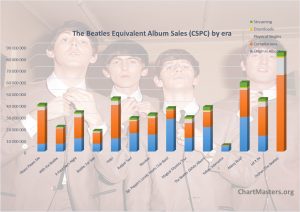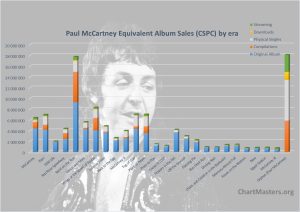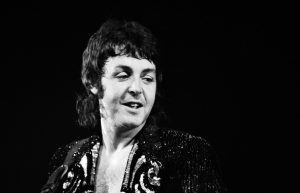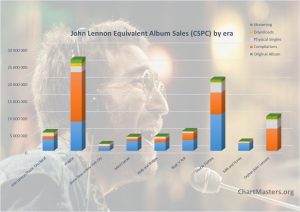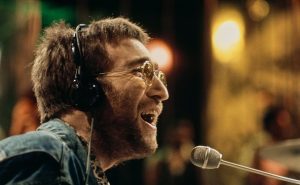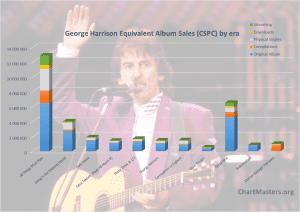George Harrison albums and songs sales
The Beatles albums and songs salesFrom the quiet Beatle days to the monumental success of My Sweet Lord, George Harrison had perhaps the most impressive trajectory among the four Beatles.
A couple of years younger than his bandmates, his passions for folk music, the Indian culture and spirituality heavily influenced the most famous rock band of all-time. They also paved his way all along his 50-million records selling solo career that we portray in numbers inside this study.
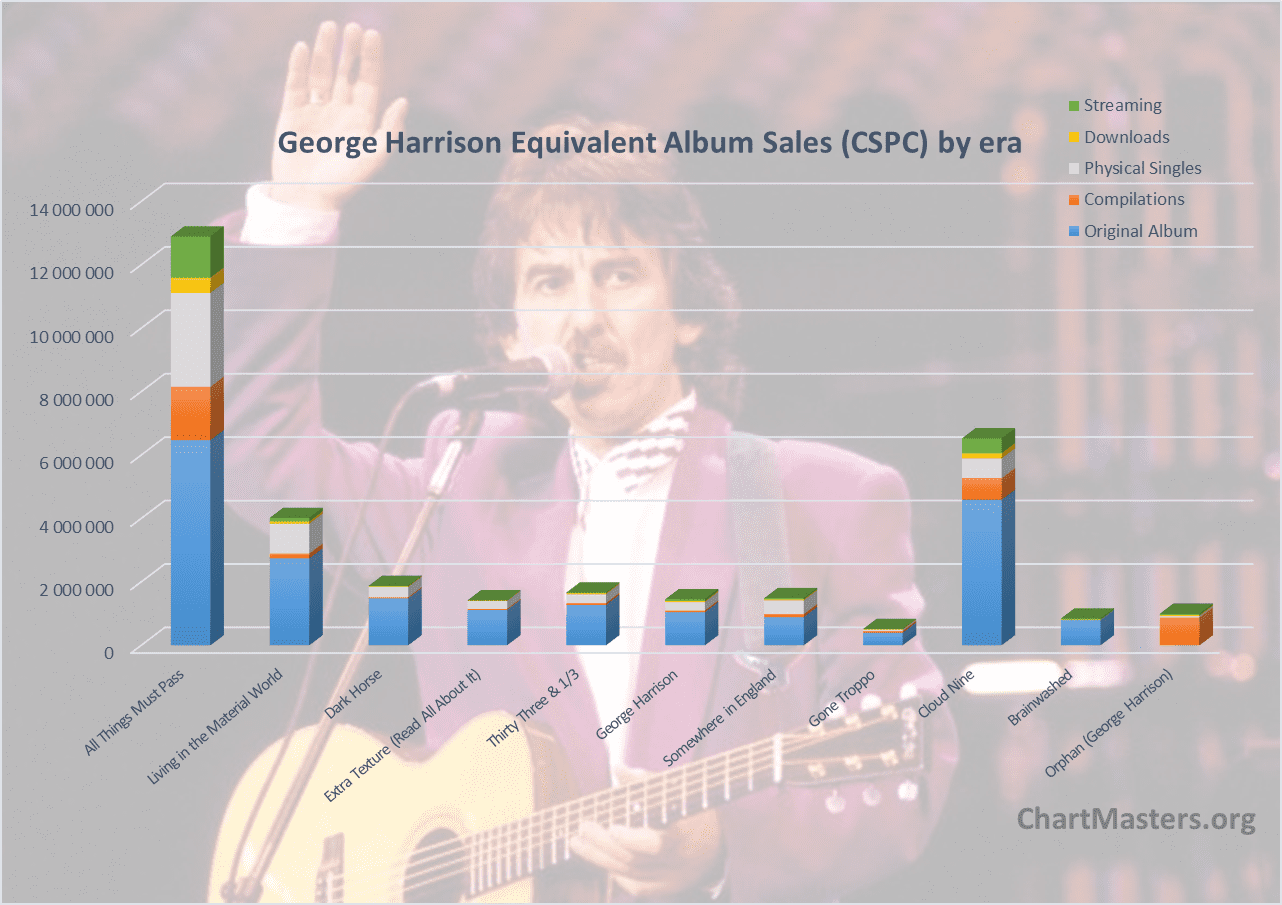
Looking at the big picture: George Harrison
Guitar is all you need (1943-1958)
Born on February 25, 1943 in Liverpool, England, George Harrison grew as the youngest of four children in a loving family. They weren’t comfortable financially speaking, but his parents made sure their kids could follow their studies in a stable environment.
The little George did just that. While competing his grades, he developped a real interest for music. In love with rockabilly legends, by the time he was a teenager he was obsessed with guitars. His mother bought him one when he was 14, and he started to learn and play.
He quickly formed his first skiffle band with his brother and a friend. On his way to the High School for Boys, he met with an older attendee of the institute who took the same bus as him, and was also heavily into music. This new friend was no other than Paul McCartney.
The making of the Beatles (1958-1962)
The latter was part of a skiffle group too, the Quarrymen, founded by John Lennon a couple of years earlier. When he saw what he was capable of, McCartney wanted to enroll Harrison into his band, but Lennon thought that the 14-years old kid was too young despite his obvious skills.
By spending time and playing together, Harrison effectively ended as the lead guitarist of the band. As they changed their sound to the booming rock and roll, remaining members of the Quarrymen left, leaving Lennon, McCartney and Harrison alone on board. George dropped out of school at 16. The band, which changed of name multiple times, continued to build their reputation through various gigs.
On October 1960, the Quarrymen now known as the Beatles, had the chance to play on clubs in Hamburg, Germany. Yet to turn 18, Harrison was soon deported because he was too young to play on nightclubs, he still had the chance to meet with the Hurricanes, and their drummer Ringo Starr. They remained tied with the German city, signing with Polydor to back up Tony Sheridan, credited as The Beat Brothers.
In 1962, the group signed a recording contract with EMI thanks to entrepreneur turned manager Brian Epstein. Their move from popular local live performers to recordings artists was done, and the rest is history. Soon, Love Me Do, Please Please Me and P.S. I Love You were on tape, and the four young boys were on their way to superstardom.
A free mind inside The Beatles’ madness (1963-1970)
Always fully concentrated while playing his guitar, and not the natural smiling man that was Ringo Starr, at first George Harrison was identified as the quiet one in the group. On record, his input was everything but quiet though.
Each of the Beatles‘ albums had their 1-2-3 songs sung by Harrison, including the US #2 hit Do You Want to Know a Secret from their debut. He was a songwriter too, although none of his songs became a single in the first part of their career.
Early, he got deep into the Indian culture. He loved their music, their instruments, their spirituality, their vision of life, and Hinduism. He played traditional instruments on the Beatles‘ songs, including Norwegian Wood (the sitar that he learned from Ravi Shankar) and Strawberry Fields Forever (a swarmandal). Despite being part of the most popular band in the world, Harrison had his mind on yoga, meditation, learning from Krishna, eating vegetarian by the end of the group, and, well, experiencing with LSD or cocaine.
He was still in love with his teenage passions, like F1 racing, and, of course, guitars. A close friend of him was Eric Clapton. With him, he wrote While My Guitar Gently Weeps for the White album, giving him a new credibility as a writing force. When recording Abbey Road, his couple of contributions would end up as some of the most remembered Beatles songs ever, Something, his first single A-side, and Here Comes the Sun.
When the band split at the end of the 60s, Harrison was ready to fly on his own. In fact, he had plenty of material he had been working on that couldn’t be released since the Beatles‘ albums only included a couple of songs from him.
Hare George (1970-1973)
Technically speaking, Harrison released two studio albums before leaving the Beatles, 1968’s Wonderwall Music and 1969’s Electronic Sound. Contractual constraints meant these records couldn’t be real pop records, instead they were instrumental experimentations, with limited commercial appeal.
His real debut was going to be a big, ambitious one. All Things Must Pass was not a single, nor a double, but a triple album! It took forever to record, with plenty of contributions from A-League musicians like Eric Clapton, Ringo Starr, Peter Frampton, Ginger Baker, Billy Preston and many more. Plus Bob Dylan pairing with him on the opening track I’d Have You Anytime.
It was worth it as both the album and its lead single My Sweet Lord shoot to the top of charts all around the World. He was the first Beatle to get a solo #1 hit, in the last week of 1970. When Lord got there, Harrison had been on top with the Beatles‘ For You Blue that he wrote (a double A single with The Long and Winding Road, their last) just 6 months earlier. The album led for 7 weeks in the US, one of the blockbusters of 1971 along with Carole King‘s Tapestry and Janis Joplin‘s Pearl, although Harrison‘s effort was way bigger internationally.
On top of his popularity, he organized The Concert for Bangladesh in August, a charity event to help with victims of the war in this country. He invited the most talented artists both Western and Indian. Concerts drew 40,000 people and by the end of the year, the album, another triple record, was released and sold huge amounts as well. It was awarded Album of the Year by the Grammys.
In 1973, he returned with the album Living in the Material World. While not as big as its predecessor, it was a success on its own. Its lone single, Give Me Love, removed Paul McCartney & Wings‘ My Love from the top of US charts. At that point, both McCartney and Harrison had two chart toppers, while Lennon and Starr were still seeking their first one.
Dark years (1974-1986)
With Harrison exploring more and more intensively his spirituality, with Indian references overly present on his lyrics and instrumentations, both live and on record, he started to lose a broader commercial appeal. His albums Dark Horse (1974), Extra Texture (1975, his last on Apple Records), Thirty Three & 1/3 (1976, his first on his own Dark Horse label) maintained consistent sales, but crossover hits were escaping him. In these years, he got 6 top 40 hits in the US, and 2 in the UK, but none made the top 10.
The roll out of Thirty Three & 1/3 was especially painful. All ex-Beatles had their contract with Apple Records running out in the end of 1975. Only McCartney renewed. Both Lennon and Starr got their solo compilation (Shaved Fish and Blast From The Past, respectively) out before the end of that contract, which granted them control over the releases and their content.
Harrison‘s own compilation came out after the end of the said contract, so he had no words to say anymore. Parent company EMI took two infamous decisions. They released The Best Of George Harrison at the same time as Thirty Three & 1/3, to compete with the Dark Horse label release. And they also filled the first side of the album with Harrison‘s compositions for the Beatles, like Here Comes the Sun, with his solo songs occupying only 6 slots out of 13. This was regarded as insulting from both fans and critics. This remained the only compilation from a living member to mix both careers, solo and band.
After divorcing and marrying a second wife, Olivia Arias, in 1978, the songwriter returned with a self-titled effort. 1979’s George Harrison followed patterns of its predecessors, selling decently without denting the top 10s of the main charts. The same happened with 1981’s Somewhere in England. That’s despite the presence of the #2 single All Those Years Ago, which featured McCartney and Starr, paying tribute to Lennon after his murder.
The following year, Gone Troppo bombed hard. It peaked at a dreadful #108 position in the US, while failing to enter UK charts. Harrison somewhat retired from popular music after this major blow.
Back to back to back smash projects (1987-1996)
While it felt that his golden years were long gone, with no big hit outside of the Lennon tribute in more than a decade, Harrison was responsible for one of the most impressive comebacks of the 80s. After developping a close friendship with Electric Light Orchestra‘s founder Jeff Lynne, he decided to bring him on as a co-producer on his new album, 1987’s Cloud Nine.
A return to pop rock sounds, with contributions from Eric Clapton on guitar, Ringo Starr on drums, and Elton John on piano, the album smashed. It went top 10 on both the US and the UK on the heels of Got My Mind Set On You success. The song peaked at 2 in the UK, and topped US charts in-between Whitney Houston and Michael Jackson. Suddenly, Harrison was cool again. And after being the first ex-Beatle to top US charts, he also became the last to do so.
From 1988 to 1992, Harrison embarked on a new musical journey. He founded the most oustanding supergroup that has ever been, teaming with Bob Dylan, Jeff Lynne, Roy Orbison and Tom Petty to create the Traveling Wilburys. The quintet released Traveling Wilburys Vol. 1, which quickly sold in the millions thanks to the strong single Handle with Care. After the passing of Roy Orbison in 1988, they issued a follow up as a quartet, titling it Traveling Wilburys Vol. 3.
They never toured together, in fact Harrison had yet to tour since the disastrous US 1974 shows. He did return to the stage by pairing with Clapton on his Japanese tour in 1991/1992. From 1994 to 1996, Harrison contributed to the Beatles‘ Anthology project, along with McCartney and Starr, reworking some demos and recording interviews.
Final days (1997-2001)
An heavy smoker for decades, Harrison was diagnosed with throat cancer in 1997. Dealing with cancer and radiotherapy is already a nightmare by itself, the guitarist also had to deal with a violent attack. In the final days of 1999, when his cancer seemed recovered, a schizophrenic agressor entered his home and stabbed him more than 40 times with a kitchen knife. His wife was able to hit the attacker from behind and stop him, saving her husband’s life.
After that, cancer returned, and a brain tumour followed. He passed away on November 29, 2001, aged 58. He was survived by his wife, Olivia Arias, and their son, Dhani. A musician himself, Dhani would go on to finish demos from his father along with Jeff Lynne to publish a posthumous album, 2002’s Brainwashed.
ChartMasters’ method: the CSPC
As usual, I’ll be using the Commensurate Sales to Popularity Concept (CSPC) in order to relevantly gauge the act’s results. It will not only bring you sales information for all albums, physical and download singles, as well as audio and video streaming. In fact, it will really determine the act’s popularity.
If you are not yet familiar with the CSPC method, below is a nice and short video of explaining the concept. I recommend watching it before reading on and to the sales figures. You’ll get the idea in just two minutes.
And if you want to know the full method as well as formulas, you can read the full introduction article.
Now let’s get into the artist’s detailed sales figures!
George Harrison album sales

Updated studio album sales & comments
What a nice way to start. George Harrison kicked his solo career with a 6.5 million seller in All Things Must Pass. Once we consider how expensive this set was due to its triple album nature, these numbers are incredible.
Living in the Material World was very relevant by itself, shifting 2.75 million copies. While numbers were going down, albums from Dark Horse to George Harrison stood afloat, moving over a million on average.
Gone Toppo managed to sell 400,000 copies thanks to budget lines, which ultimately isn’t as terrible as one could expect giving its chart history.
Cloud Nine went on a heater, cracking 4.5 million sales in total. Brainwashed did 800,000. In total, these 10 studio albums sold close to 21 million copies.
Want to compare the act’s albums with others?
George Harrison songs sales
Below, we list down results from the artist through physical sales, digital sales and streaming.
Please be aware that when the artist is regarded as the lead act, they are rewarded with 100% of these units. However, featured acts share a 50% piece of the total.
Physical singles
With well past 7 million sales, My Sweet Lord is on a league of its own. In fact, even accounting for the biggest hits of the Beatles, it ranks second topped only by Hey Jude, which had the advantage of not being part of a studio album.
In detail, the version paired with Isn’t It A Pity sold almost 6.5 million, including over 2 million in the US. The single coupled with What Is Life sold over 900,000 copies, most of which from the UK. The 2002 reissue sold 375,000 copies.
Speaking about What Is Life, it got its own single outside of the UK, selling 2 million units globally, including over 800,000 in the US. It was a #10 hit there, while topping charts in Australia and Switzerland.
Next up at 1.8 million is Give Me Love (Give Me Peace On Earth). The #1 single in the US, selling almost a million there, wasn’t as strong abroad even if it did well, with over 500,000 sales across Europe. Reverse patterns for Got My Mind Set on You. With the US single market in dire straits by late 80s, the song couldn’t sell more than half a million there despite its chart topper status. It improved this tally in Europe with nearly 900,000 sales.
1971’s Bangla Desh and 1981’s All Those Years Ago comfortably topped the million mark in global sales. Around half a million sales were his other Top 50 charting hits, namely Dark Horse (#15), Ding Dong (#36), You (#20), This Song (#25), Crackerbox Palace (#20), and Blow Away (#16). Only When We Was Fab (#23) stands a bit lower at 280,000 sales.
During his career, Harrison sold over 20.5 million physical singles, almost the same as with his studio albums.
Digital songs
No suspense there: the signature song of Harrison is My Sweet Lord. Despite the much touted copyright infringement suit, which lasted from 1971 to 1976 for the main case, and all the way until 1998 until all details were sorted. Even if the judge ruled that the Beatles star subconsciously copied the Chiffons‘ He’s So Fine, the public loved and continue to love My Sweet Lord. Digital sales of 1.8 million copies demonstrate it.
While this track is the clear frontrunner, several more songs enjoy solid sales as well. These include Got My Mind Set on You, not too far away from a million, or What Is Life over half a million. A total of 12 tracks top 100,000 in digital sales, including 5 from All Things Must Pass.
Streaming
Streaming is made up of both audio and video streams. Our CSPC methodology includes both formats to better reflect the real popularity of each track.
The main source of data for each avenue is Spotify and YouTube, respectively. To factor in the growing impact of multiple Asian countries where these platforms aren’t always the go-to site for music streaming, more sources have been added.
In order to account for their real popularity in each relevant country, the below sources have been used along with the mentioned ratios that reflect the market share of each area.
Audio Streams
– South Korea: Genie streams * 2.20 (consistent with Gaon streaming numbers)
– Japan: AWA streams * 100 / 4 (AWA has 4% of the Japanese streaming market)
– Arabic world: Anghami streams
– Sub-Saharan Africa: Boomplay + Audiomack streams
– Elsewhere: Spotify streams * Spotify market shares based on artists’ market distribution
Video Streams
– China* : QQ video streams * 50 if the song is available for audio stream, QQ video streams * 5 elseway (scale built based on known figures for several major artists)
– Elsewhere : Youtube views increased by 10% to account for various local platforms
*since Chinese streaming platforms are mostly video streaming platforms, their streams are weighted on par with YouTube streams.
Audio Stream value – 1,500 plays equal 1 album unit
Video Stream value – 6,750 views equal 1 album unit
Equivalent Albums Sales (EAS) = ( Spotify * ArtistRatio + Genie * 2.20 + AWA * 100 / 4 + Anghami + Boomplay + Audiomack ) / 1500 + ( QQ views* 50(or 5) + YouTube * 1.1 ) / 6750
Top hits

Just like with downloads, My Sweet Lord dominates the streaming ranking. The track has an uncontested lead in every platform, Spotify, YouTube, QQ, Genie and AWA. On the latter, it is now past 500 million, while Lord tops a quarter of a billion on YouTube.
Got My Mind Set on You is an expected runner up, with perhaps better than expected numbers. Nowhere near as critically acclaimed as Lord nowadays, the 1988 hit claims 365 million streams on Spotify. What Is Life completes a solid top 3, with 166,000 equivalent album sales from streams.
Obviously, All Things Must Pass leads among albums. It lands 14 tracks inside the top 20, for a total cracking a billion streams on Spotify alone.
Full catalog breakdown
If you are familiar with the artist’s catalog and want to check details of each and every song, you can access to all of them right here.
Keep yourself up to date
Our website provides you a fantastic tool which fetches updated Spotify streams as you request them, use it to watch these results grow day after day!
George Harrison compilations sales
It sounds fairly logical to add together weighted sales of one era – studio album, physical singles, downloads, streams – to get the full picture of an album’s popularity.
However, older releases generate sales over various live, music videos and compilation albums. And all those packaging-only records do not create value. They exploit the value originating from the parent studio album with each of its tracks instead. Inevitably, when such compilations are issued, they downgrade catalog sales of the original LP.
Thus, to accurately gauge the worth of these releases, we need to re-assign sales proportionally to its contribution of all the compilations which feature its songs. Here is how we do that.
Assigning compilation sales to original studio albums

How do you understand this table? For example, if we check the The Best Of George Harrison line, these figures mean it sold 2,715,000 units worldwide. The second statistics column means all versions of all the songs included in this package add for 3,635,421 equivalent album sales from streams across all formats.
The second part (on the right of the table) shows how many equivalent streams are coming from each original album, plus the share it represents in the overall package.
Therefore, the streaming figures convey that songs from All Things Must Pass equate to 23% of The Best Of George Harrison tracklist attractiveness. Meaning, it generated 635,000 of its 2,715,000 album sales and so on for the other records.
Raw compilations sales
The infamous The Best Of George Harrison sold very well – over 2.7 million copies to date. Back then, it was noted as the only compilation from the 3 ex-Beatles exiting Apple Records to reach Gold status in the US. The caveat is that these great sales were achieved thanks to the presence of very popular Beatles tracks, which means these sales are redirected to their original album as per our CSPC process.
Before that, The Concert for Bangla Desh also did wonders, selling 3 million units. It had its own controversies, with funds for the charity getting blocked for a decade as the event wasn’t declared properly to UNICEF. The album was out of print for years due to contract issues too.
During his second golden period, another live and another best of sold half a million copies each, Best of Dark Horse 1976-1989 and Live in Japan. His last strong selling compilation was the posthumous Let It Roll: Songs By George Harrison, now over 700,000 sales.
Re-assigned compilation sales – Results & comments
Here is the most underestimated indicator of an album’s success: the amount of compilation sales across all versions that were generated. Due to the dependency of sales of the original studio albums on these releases, they are a key piece of the jigsaw.
To clarify that, we take the Raw compilation sales results and assign the numbers to the related original studio albums, as described in the first section Assigning compilation sales to original studio albums.
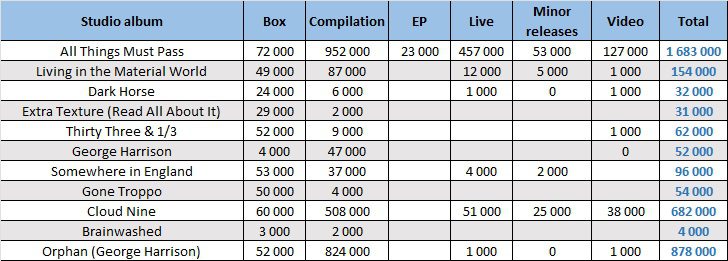
As previously mentioned, a good share of Harrison live and compilation sales are indeed powered by Beatles recordings. Among his own catalog, All Things We Pass is very clearly his strongest asset, being responsible for 1.7 million sales.
Bonus: Total album (all types) sales per country
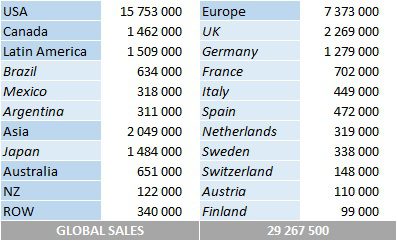
Please note country-specific numbers may miss sales of a few minor releases, although totals are complete.
George Harrison: career results (CSPC)
So, after checking all the figures, how many overall equivalent album sales has each album achieved? Well, at this point we hardly need to add up all of the figures defined in this article!

Albums results (CSPC)
In the following results table, all categories display figures in equivalent album sales. If different, pure sales are listed between parentheses.
As a reminder:
- Studio Album: sales of the original album
- Other Releases: sales of compilations generated thanks to the album
- Physical Singles: sales of physical singles from the album (ratio 3/10)
- Download Singles: sales of digital singles from the album (ratio 1,5/10)
- Streaming: equivalent album sales of all the album tracks (ratio 1/1500 for Audio stream and 1/6750 for Video stream)
Artist career totals
See where the artist ranks among remaining singers
Of course, when you are constantly compared with John Lennon and Paul McCartney, or even The Beatles, it’s difficult to look amazing. In all fairness, George Harrison sales are really good on their own.
His strongest LP is All Things Must Pass. All considered, the album is now close to 13 million sales. Cloud Nine concludes on 6.5 million units, while Living in the Material World tops 4 million.
The singer songwriter has no other album in the multi-million region, but his 5 releases from 1974 to 1981 are all healthy at 1.4-1.9 million. The remaining albums, Gone Troppo and the posthumous Brainwashed, are over half a million.
In total, George Harrison sold 30 million albums, although 5 million of these sales were powered from songs of his former band. He also moved over 20 million physical singles and 5 million downloads, a total well past 50 million. These sales, added to streams, are worth 33.7 million equivalent album sales. This is noteworthy from a discography limited to 10 albums spread over more than 30 years.
Singles results (CSPC)
The list is compiled in album equivalent sales generated by each song. Therefore, these figures are not merged units of singles formats. Instead, the list includes weighted sales of the song’s physical single, download, ringtone and streaming as well as its share among sales of all albums on which it is featured.
Want to compare the act’s songs with other top hits?
Discography results (ASR)
Thanks to our new ASR (Artist Success Rating) concept, we know that sales represent 0.90 million times the purchase of entire discography. Coupled with total sales, it translates into an ASR score of 22. The ranking of all artists studied so far is available too at this link.Records & achievements
- At 7,757,500 sales, My Sweet Lord is one of the best selling physical single of the 70s.
- At 12,893,000 EAS, All Things Must Pass is among the 20 biggest albums from 1970.
- Either as a singer or a songwriter, Harrison released US #1 hits in three consecutive decades (60s-70s-80s).
Dynamic Spotify key performance indicators
George Harrison

Current followers count: 3,031,819 3,000,000 followers have been reached on 07/26/25 2,000,000 followers have been reached on 11/27/21 >> Daily breakdown
George Harrison is #1348 among the most followed artists of all-time >> Visit our Top 5,000 most followed artists ranking
Current streams count: 2,127,679,661 2,000,000,000 streams have been reached on 05/23/25 1,000,000,000 streams have been reached on 05/15/25 2,000,000,000 streams have been reached on 04/24/25 1,000,000,000 streams have been reached on 06/30/23 >> Daily breakdown
George Harrison is #1409 among the most streamed artists of all-time Popularity Rating: /100 >> Visit our Top 1,000 most streamed artists ranking >> Visit our Top 20 highest rated artists ranking
Current monthly listeners: 9,270,468 (Trend: 0) Global chart position: N/A The artist top 50 cities come from 19 distinct countries >> Global impact breakdown
As usual, feel free to comment and / or ask a question!
Sources: IFPI, Spotify, YouTube, Discogs.
You may be interested in…
… George Harrison‘s streaming masters analysis
… checking out the upcoming artists or even voting for them!
… similar artists
… best-selling artists, albums, and singles
Artists
360° analytics – Best-Selling Artists | by Decade
Tools: Artist Dashboard | Artists Comparator
Streaming deep dive – Most-Streamed Artists
Tools: Playcounts | Royalties | Global Reach | Stats History
Other KPIs – Monthly listeners | Followers | Top money makers










